60 min render cut to 9 min
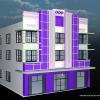 alan bard newcomer
Posts: 2,247
alan bard newcomer
Posts: 2,247
render times we all obsess over it.
---
I've been working with a complex piece of art and have ended up doing it in bits and pieces because of the ability to change the background etc in photoshop
But the other day I was minded it's not just the objects in the scene but the lights.
---
first image took 60 minutes to render ... it's saved as tiff but posted as a jpg so the white is transparent for photoshop.
Okay, I wasn't really watching the time I was doing other things but eventually I did notice it was taking a long time
And then my mind pointed out that when I was building the model from the front corner my test renders of it were much faster.
fifth image is the photoshop will all layers active and 6th image has the brighter hitchhiker which took about 3 minutes to render as it was just the car with brighter lights and the hitchhiker.
So I rendered just the house .,.. 4 minutes
then I rendered the background scene without the red house -- it's white but the lights are red from the gas pumps.
that took 5 minutes.
put them in photoshop as layers to get picture 4
60 minutes cut to 10.
What happens... same models, textures etc.
In the first render the iray engine checked every point in the scene to see if each light on the building interacted with it.
as shown in the last composite... not any interaction to mention but the render engine check them all
The other time I noticed this was when I was using a red light up front and again just rendering the light and the front object removed all the interaction with the background with a huge drop in render time for doing the background and foregrounds separately
In fact for light control it's almost necessary to do this one in bits.
down in the very front corner on the road is a hitchhiker ... need to render him separately in order to bring up the light levels a little which took 3 minutes.
----
this is with a titanx so I would guess that all these numbers would be cut quite a bit with a newer card.
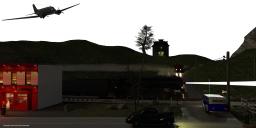

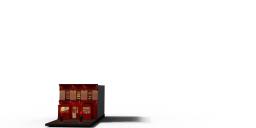

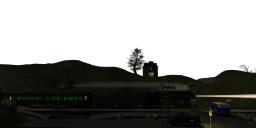

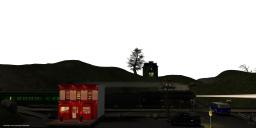

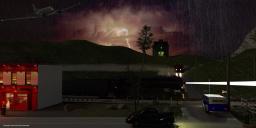

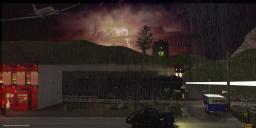



Comments
First question is obviosuly did it frop to CPU with the full render, but having a back-lit object like that probably will slow the render down if the light from the background elements can occasioanlly reach the foreground, meaning the values of those pixels can take a while to fully settle.
I can safely say "not a chance" haven't had anything go to cpu since the option to cancel that was added and since I no longer have battle encoder running all the time with daz limited to to 66% if it dropped to cpu the cpu usage would go to 100% and the computer would lock up. And dual 8 thread xeons get extremely noisy at 100% usage.
And no lights in background because no background in the rendering of building and train.
Plus it's a 12g card so I don't think I've even overloaded the card (come close at 11888m).
But happened before and with something else with red light (although you'd think that the light color wouldn't matter so it may have been both were dark scenes)
Again in this set I ended up doing the background just a sky of iradiance and the scenery
then the girl and a bright emmisive dragon
then just the dragon
put all in photoshop, erased the bright dragon and got final image
but I did cut iray from trying to interact the light from the dragon with the scenery
with a significant drop in time.
---
Iray functions like like within limitations of our programs and hardware .. when our eyes see something the raytracing has already happened at the speed of light whereas our computers don't run quite that fast and can only process one ray at a time
If there is something filling an area in a scene it has to trace it but it that spot is empty it ignores it.
---
last image with the buildings took 47 minutes, lots of emissive lights but nothing really dim which may be why it rendered faster than the building with red light on the pump and just some of the scenery.
sometimes I give things useful names.. "47m 6s 410 11879mbF" 47 minutes daz 4.10 11879 m on card Full scene. the geometry had to be all on the titanx but the 980ti was still showing 5500m of usage so the render engine had to be using it also.
Rendering separate objects will not compute the lights/shadows and reflections right, so this is usually avoided in pbr. But if a realistic render is not required then of course it renders faster because there's less light interaction among objects. You may get a similar result by limiting the "max path length" in iray, provided that the vram is not a issue.
it does vary by subjects... in thses samples... the front lights aren't close enough to interact ... but the render engine doesn't know that ... it checks every thing to see if it will.. unless there's nothing there (and empty space in the scene) and then it doesn't check
And part is the fact these are low light situations... so apparently the light level (inverse proportion of the square of the distance or such for how much illumatnaion is delievered from a light source.
with the low light levels I think it traces the ray and says "oh not enough light in this path" I did do a render yesterday of the same ground but under daylight not night time sky and it as much longer because as it checked each possible ray there was enough strength that it did generate changes between objects.
But usally a quick look will give you an idea... if the entire scene is a room ten feet deep then anylight will probably interact... If it's an exterior that's very large ... then illumation sources (other than the sun) will probably not extend very deep.
----
Everything is also complicated by the fact that our eyes still see things more than cameras etc can see. --- I think there are settings to finese seeing in highlights and seeing in dark spots... in iray...but our brains which (if not in thinking) but in visual processing certainly outdo video cards... thing how that huge scene outside your window is rendered instantly in your mind.
I'm sure they've finally updated the followspots used in concert etc with the new Leds etc... but a supertrooper with carbon arc was needed to throw a visible light the leight of an auditorium but a regualar spotlight in the same location would never extend it's rays that far.
You could probably design a test scene with balls heading out straight back and 45 and -45 degrees back .... and then seeing how far any given light was illuminating